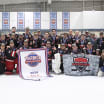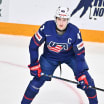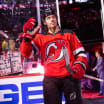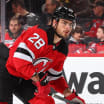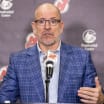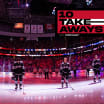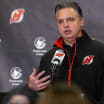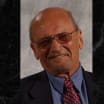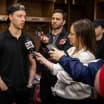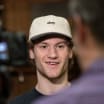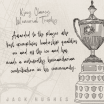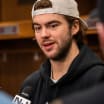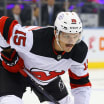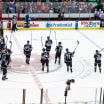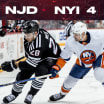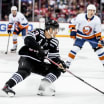As he prepares for his second NHL Draft as Devils director of amateur scouting, Paul Castron took some time to explain exactly how the team's draft list is put together, the value of the NHL Scouting Combine and what really gets him excited about the Draft.
Ten Questions with Devils Director of Amateur Scouting Paul Castron
Julie Robenhymer checks-in with Paul Castron at the NHL Scouting Combine
By
Julie Robenhymer @JulieRobenhymer / newjerseydevils.com
Q: Let's start with your staff. How many people are involved?
A: For starters, [assistant director of amateur scouting] Gates Orlando is my right-hand man. I lean on his experience both as a former player and a scout. He's been doing this a long time and been with the Devils for a long time, and I respect his judgements and evaluations. Then we have three guys in Western Canada, three guys in the U.S., two in Ontario, two in Quebec, three in Europe and two in Russia. There's a lot of areas and a lot of hockey to watch and you think you might have it all covered, and then some other team picks a guy and you're like, "Who's that? Where'd he come from?" And then he makes it, and you're scrambling even more wondering, "How the hell did we miss him?" But it happens because there's just so much hockey and so many players.
Q: After every game your scouts watch, they file a report on the players involved. When the season is over, about how many reports do you have on each guy?
A: I'd say minimum 20. An area guy alone would have seven to 10, and we have at least two guys in each area. Then you have all the international tournaments. There are four of those a year with at least four games and those are generally all the tops kids available for the draft. So that's even more reports on each player. Then, if someone really likes a guy, I'll go out a see him play more than I had originally planned just to see if the consistency is there and to say, "Oh, OK. I see what you see in him." But even if he has a bad game when I see him, I'm not going against the opinion of my guys who have seen him play five, six, seven games. I trust them to do their job and do it well and will try to go see that kid again if good reports keep coming in on him. But that's why we have a minimum of 20 reports on a guy. You get a more complete picture of what he can do for you that way.
Q: You had your end-of-season amateur scouting meetings in the beginning of May. What happens in those meetings?
A: Basically, we'll start in one area and the scouts from there will take the floor and tell us about the top 20 guys in that area. Then we'll talk about those 20 guys. We won't always agree about the order and that's kind of up to me and Gates to see how strongly one guy pushes for a certain player, and we might make a few changes but we usually go with their order. Sometimes we'll have a discussion and say, "Hey, this guy at 14 is good, but doesn't the guy you have at 20 have a little more upside? Maybe he's only 5'8" and not strong enough right now, but projecting ahead, doesn't he have a stronger chance of making it because of his skill?" Those are the types of discussions we have and if Ray [general manager Ray Shero] or Fitzy [assistant general manager Tom Fitzgerald] or anyone else wants to see video, we just pull it up on the monitor and see clips on a kid. Then once we go through each area we have to try to mesh the lists together. Last year, we ended up with a list of about 100 guys in numerical order and then we'd ask for an extra five or so guys in each area to round out our final list heading into draft weekend.
Q: If you end up with a list of 100-125, that only covers the first three or four rounds. What do you do for the last three rounds?
A: Well what happens is there are so many guys that you don't like for one reason or another and don't feel confident or comfortable drafting them and they get drafted by other teams. For example last year, by the end of the draft we still had four names on our 100 list that hadn't been drafted. Just because a player isn't on our list doesn't mean he isn't on other lists. That's why when there's a player that you had at 20 who's still available at 36, you get a little excited about the possibility of taking a guy you had in the first round in the second, and maybe that's when you trade up a few spots to make sure you get him. Like last year, we took [Nathan] Bastian in the second round. He was No. 26 on our list and I think we got him at 41. So in our mind, we got a first-round player in the second round. We were excited about that.
Q: How important is it to really do your homework before draft weekend?
A: You don't have any time to do your homework on the second day because sometimes it's like 40 seconds between picks. That's why it's so important to be as accurate as you can when putting the list in order and trusting your decisions. After the first round, we'll go back to the hotel and go over our list and get prepared for day two. We have the players ranked by number, but then we also have them sorted by type of player - defensive defenseman, two-way defenseman, offensive defenseman, skilled forward, two-way forward and then we have another category for special players who might not have all the tools needed but there's just something special about them. So let's say 26 on your list is a defensive defenseman and 27 is a skilled forward and 28 is a special player, they will actually show up in our system as tied for 26, and then you have to make a decision on who you want to take. Like last year, in the fifth round, we had taken all these forwards in the previous rounds and Ray kept asking, "What about a defenseman?" And we ended up taking Yegor Rykov. There were a couple forwards we had ranked ahead of him, but he was the next defenseman on our list so we took him.
Q: What do you do during the interviews at the NHL Scouting Combine?
A: We have a big book on each of these kids and we try to leave no stone unturned when it comes to finding out as much as we can about them both on and off the ice. So during the interviews, we have a list of questions we want to ask them about what we found and we want to see how realistic they are with their expectations. A couple kids said they were ready to play in the NHL next year and they're not. It's just not realistic. So it makes you wonder if he knows what it takes to play at this level or even if he knows what kind of player he is. It's nice that they have that confidence and that they want to play in the NHL, but you have to be realistic. It's a pretty hard league to step into. So we have all these notes on a player that we're looking over while they're talking and checking our reports and trying to see if he's what we're looking for and if he can improve our team.
Q: How hard is it to not compare these players as they are today, but rather how they will be a few years from now?
A: I have to keep reminding myself and the whole staff that we're in the projection business. I think it's so easy to get caught up in the thought that this guy scored 40 goals this year and that guy only got 15, but maybe the 40 guy got way more ice time or was on a better team and that's why he had better numbers … does that necessarily mean he's a better player? What about five years from now? It's hard because numbers do jump out at you and they're hard to ignore. For example, Cody Glass (projected as a top-10 selection) had 94 points last year and there's nothing to him (6'2", 170). When he puts on 25 pounds, how much better can he be? He's got a lot of upside. So in his interview I asked him to compare himself to other players in the WHL, and what I really wanted to know is if he thought he was better than Nolan Patrick and he said, "Not today, but maybe in a few years I will be." That's what we need to keep in mind as we put this draft list together. We're not trying to decide who is the better player today, but who's going to be the better player in two, three, five years - once they've filled out physically and developed their skills a little bit more. It's hard.
Q: What happens after the Combine for you and your scouting staff?
A: We'll have some conference calls. Gates and I will call each area's scouts and go over what we learned about each player here and give them another chance to weigh in with their opinion and possibly re-evaluate their list if needed. Right now, we're just massaging and tweaking. The bulk of the list is done. It's just the top part that isn't finished yet. Picking first could go down to Thursday night because that will be a big decision and Ray will obviously be weighing in heavily on that one, but even outside of that pick, there's a lot at stake and we want to get it right. So, we'll go over the entire list a few more times before we get to Chicago.
Q: What's the challenge of picking first overall?
A: Managing expectations. If you draft Patrick or [Nico] Hischier, you want points. If you don't get points, you start wondering if you took the wrong guy, but when drafting a defenseman, the expectations are less. All a defenseman has to do is his job. As long as they don't screw up every shift, they're good. But if you're a player who puts up points and you don't do that, there's a lot more criticism because expectations are high when you pick skilled offensive forwards. As far as pressure goes, there's always pressure because you want every guy you pick to make it, but usually only two or three do. With 11 picks this year, we'd like to see four or five of them make it. We'd consider that a good draft, assuming we use all 11 picks. Maybe we don't.
Q: Are you excited for this year's draft?
A: As scouts, we're excited for every draft. Our guys travel from September to May and the draft is our Game 7 of the Stanley Cup Final. It's not even just about the top-tier players. Our guys get excited for seventh-round picks. We could have a guy at 70 on our list still on the board when we're picking 200th. That's exciting for us because we're not sure if we're that dumb or incredibly lucky, but we're excited to find out. I like to use the example of Erik Karlsson a lot. Is he a superstar? Yes. Did anyone think he was going to be a superstar when he was selected 15th? Probably not, but now he looks like a Hall of Famer and Ray tells us to find the Hall of Famer all the time, and those can be found in any round. Shea Weber is another example. He went in the second round. Franchise player. Patrice Bergeron. Second round. Franchise player. So, yeah. We're excited for every pick in every round of every draft as we look for guys we think could be future Devils and that one that turns into a Hall of Famer.


